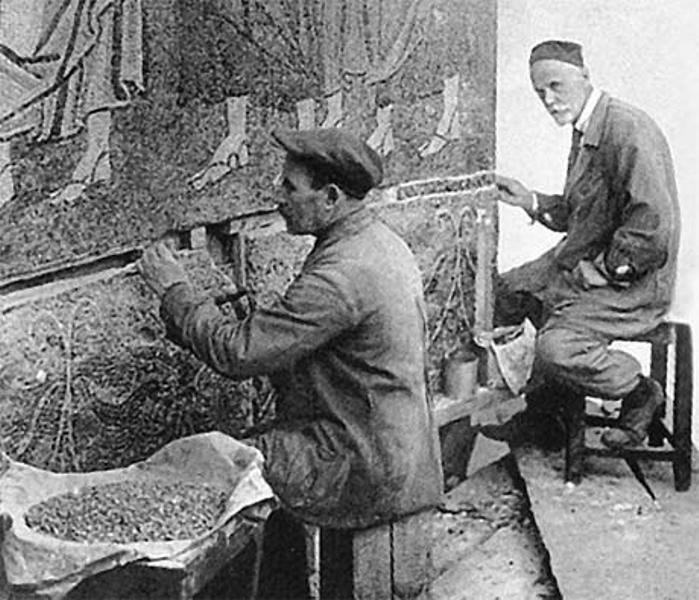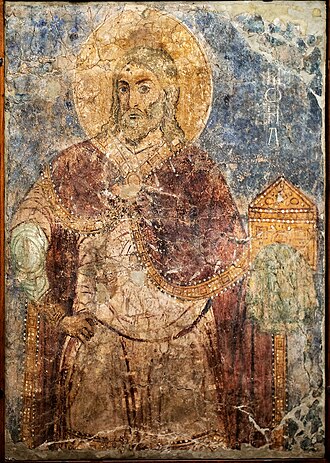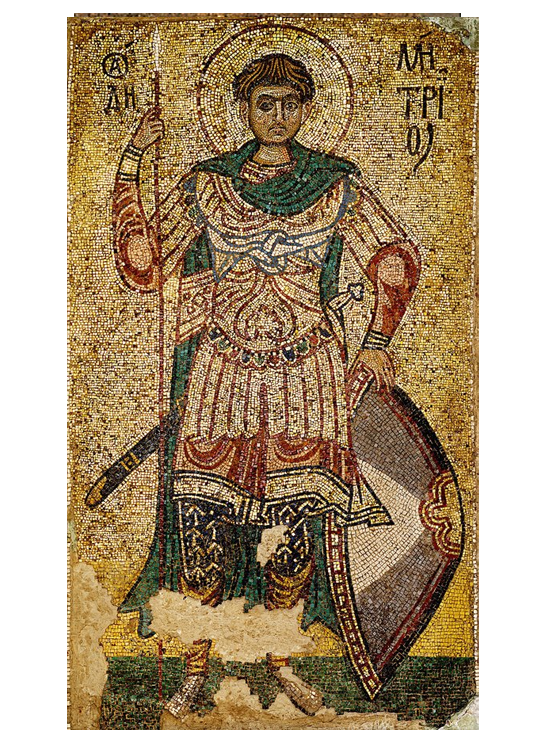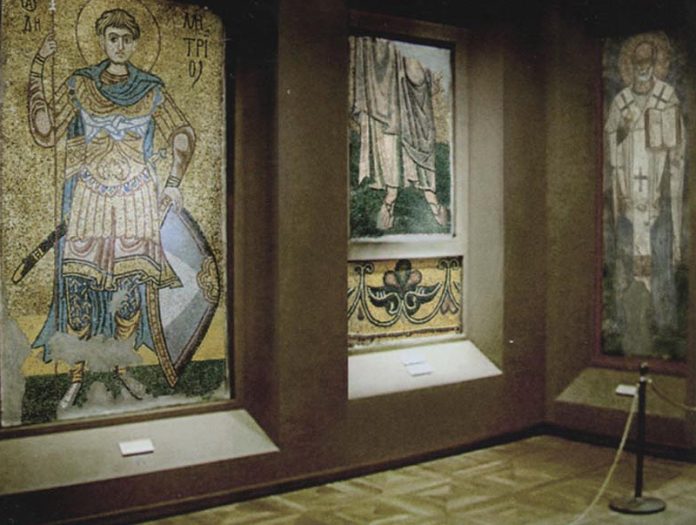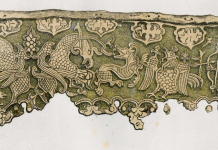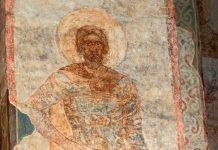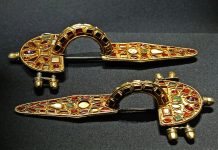St. Michael’s Golden-Domed Monastery is situated on the central hill of Kyiv overlooking the Dnieper River and the northern part of Ukraine’s capital. It was built in 1108 – 1113 during the reign of Prince Sviatopolk II of Kyiv. The monastery was princely and served as a burial place for Kyiv rulers during the 12th century. Austrian soldier and diplomat Erich Lassota visited Kyiv in 1594. He wrote a diary of his travels and described the monastery in it: “It is a fine building. In the center, it has a round cupola with a golden roof. The choirs are turned inwards and are also decorated with mosaics. The floor is laid out with small, colored stones. As one enters the church through the gates which are directly opposite the high altar, one sees on the left a wooden casket that holds the body of a saintly virgin, Barbara, a king’s daughter: she was a young girl, about 12 years old, as can be judged by her size. Her remains, covered down to her feet with a piece of fine linen, have not decomposed yet as I myself could observe by touching her feet which were still hard and not deteriorated. On her head, there is a gilded crown made of wood.” (The Habsburgs and Zaporozhian Cossacks (1594). (Note: Eric Lassotta was mistaken about Barbara. See the following quote).
The Syrian traveler and writer Paul of Aleppo visited the Monastery during the summer of 1654. In describing the cathedral, he compared it with St. Sophia in Kyiv and the Hagia Sophia in Constantinople, writing of St. Michael’s:
“The entire building is of wood, except the magnificent, lofty, and elegant church, which is of stone and lime, and has a high cupola shining with gold. This church consists only of one nave. It is lighted all round with glazed windows. The three churches I have been describing are all of one style of architecture, and of one age. As to the throne of the Chief of the Clergy, it is very magnificent and beautiful; and in the front of it, on the left, is the portrait of Theophani, Patriarch of Jerusalem, in his cap and cassock, and holding a cross. The large Tabernacle resembles that of St. Sophia, and of the Convent of Petcherske [Kyiv Pechersk Lavra], and has three large windows; and, in like manner, it is painted in the centre with the portrait of Our Lady, standing upright in her gold ornaments, and having both her hands raised and open. Next to her is Our Lord, handing to his Disciples, on both sides, the divine bread and blood. Below them are the portraits of Chief Priests, in rows, and all with inscriptions. On the right of this tabernacle is a second, with a lofty cupola: and on the left is a third. This holy church has also three doors: the largest is to the west; the other two give admission to the two choirs. At the back of the left choir is a handsome tabernacle, facing your left-hand as you enter. It has an iron folding-door reaching from the top to the bottom, and beautifully divided into compartments,, which are diversified with painted flowers and the figures of angels and saints, in the manner we described of St. Sophia. Within it is a handsome sarcophagus, containing the body of St. Barbara of Baalbec. So also on the right, as you enter the church, is another tabernacle in the western wing: and without the angle is a sixth. The floor of the church is all of large red tile. Near to this convent, and indeed contiguous, is one of Nuns. I should have mentioned, that the image of St. Michael is very magnificent and venerable; all its armour, its breast-plate, bracelets, visor and helmet, being of pure silver, coloured, and with the bosses gilt; the work of an ingenious master.”” (The Travels of Macarius: Patriarch of Antioch)
The cathedral that survived centuries was first nearly destroyed in the aftermath of World War I, when it was hit by shells fired by the Bolsheviks under Muraviev’s command. One of the arches supporting the cathedral’s central dome was destroyed, and a large hole emerged at the side of the building as a result of the shell damage. In 1919, the monastic buildings were appropriated by the Soviet government, and in 1922 was closed by the authorities. The refectory was converted into the Proletarian Students’ House, and used as a sleeping quarters. The other buildings were used by various institutions, including a driver training school.
Wikipedia: “In January 1934, the government decided to move the Ukrainian capital from Kharkiv to Kyiv, and in April a competition to build a new Government Centre was announced, to be built on the site occupied by St. Michael’s. To prevent public protests, the art critics Fyodor Ernst [uk], Mykola Makarenko [uk], and Stefan Taranushenko [uk]—who were thought by the authorities to be likely to publicly oppose the demolition—were arrested. Archaeologists, including Volodymyr Goncharov, condoned the proposed demolition of the cathedral, declaring that the buildings dated only from the 17th century. On 26 June, under the supervision of Vladimir Frolov [ru] of the Leningrad Academy of Arts, work began on the removal of the 12th-century Byzantine mosaics. They were apportioned among the State Hermitage Museum, the Tretyakov Gallery, and the State Russian Museum…”
Archaeologists who condoned the demolition of the cathedral, declaring that the buildings dated only from the 17th century sinned against their conscience, history and Ukraine because of the description of the Cathedral by the Patriarch of Aleppo quoted above, specifically – “the three churches I have been describing are all of one style of architecture and of one age“. No destruction of St. Michael’s Cathedral was mentioned in the remaining part of that century or the following one.
But the barbaric demolition of St. Michael’s Golden-Domed Monastery by dynamite took place on 14 August 1937. The Bell Tower, the Economic Gate (Ekonomichna Brama) and the monastery’s walls were also destroyed.
Independent Ukraine reconstructed St. Michael’s Cathedral in Baroque architectural forms during the 1990s. Some unique mosaics and frescoes that had been preserved in Ukraine were returned to the Cathedral. But the Muscovites had refused to give back a range of works of monumental art from the time of Kyiv Rus the frescos from St. Michael’s including even before the full-scale invasion of 2022.
New perspective on the ties between Kyiv Rus and Byzantine Empire in the 10th century including establishment of the Varangian Guards are in the “Gardariki, Ukraine” ebook.
